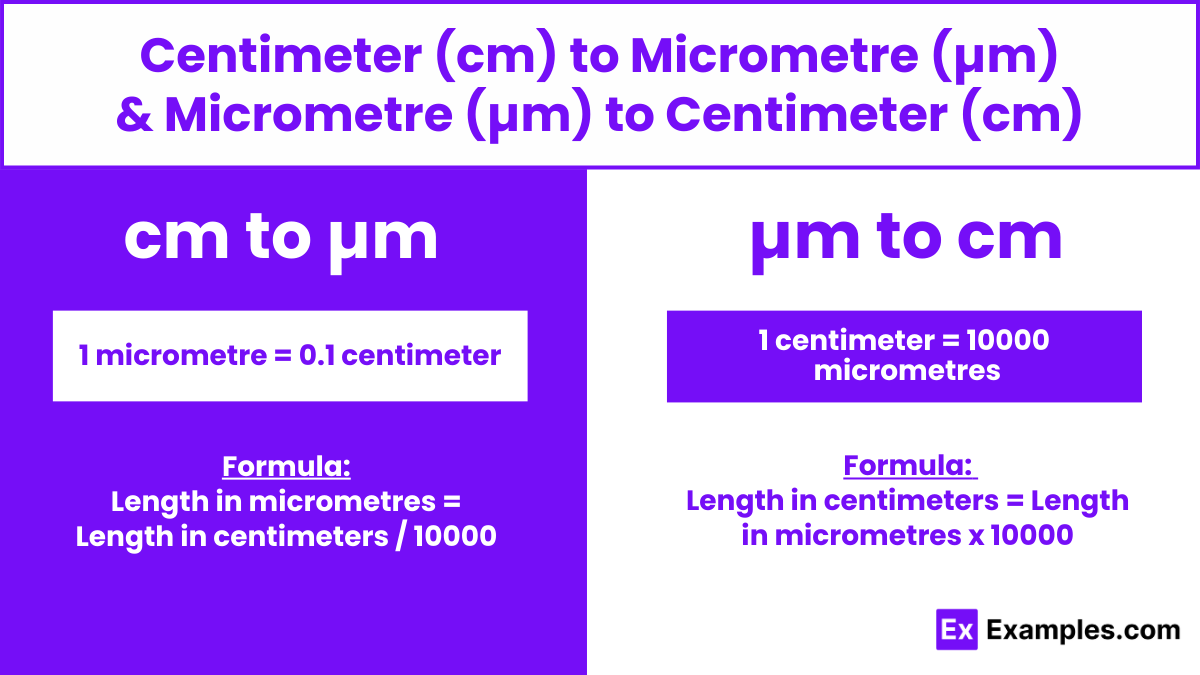Quickly and accurately convert between centimeters and micrometers, and vice versa, using Examples.com’s reliable measurement unit length conversion tool. Simply enter your value for immediate and precise results.
CM to µm
Formula: Length in µm = Length in centimeters / 10000
Centimeters :
Micrometer :
| Centimeters | Micrometer |
|---|---|
| 1 | 10000 |
µm to CM
Formula: Length in centimeters = Length in µm x 10000
Micrometer :
Centimeter :
| Micrometer | Centimeters |
|---|---|
| 1 | 0.0001 |
Length Converters to Centimeter (cm)
Length Converters to Micrometer (µm)
How to Convert Centimeter to Micrometer
centimeter = 10000 micrometer
Start with Your Number in Centimeters
Think of a number of centimeters you want to convert.
1 cm = 10000 µm
1 µm = 0.0001 cm
Example: convert 9 cm to µm:
9 cm = 9 × 10000 µm = 90,000µm
How to Convert Micrometer to Centimeter
1 Micrometer = 0.0001 centimeters
Start with Your Number in Micrometer
1 µm = 0.0001 cm
1 cm = 10000 µm

Centimeters to Micrometers Conversion Table
| Centimeters (cm) | Micrometers (µm) |
|---|---|
| 0.01 cm | 100 µm |
| 0.1 cm | 1,000 µm |
| 1 cm | 10,000 µm |
| 2 cm | 20,000 µm |
| 5 cm | 50,000 µm |
| 10 cm | 100,000 µm |
| 20 cm | 200,000 µm |
| 50 cm | 500,000 µm |
| 100 cm | 1,000,000 µm |
| 200 cm | 2,000,000 µm |
| 500 cm | 5,000,000 µm |
| 1000 cm | 10,000,000 µm |
Micrometers to Centimeters Conversion Table
| Micrometers (µm) | Centimeters (cm) |
|---|---|
| 1 µm | 0.0001 cm |
| 5 µm | 0.0005 cm |
| 25 µm | 0.0025 cm |
| 50 µm | 0.005 cm |
| 75 µm | 0.0075 cm |
| 100 µm | 0.01 cm |
| 250 µm | 0.025 cm |
| 500 µm | 0.05 cm |
| 750 µm | 0.075 cm |
| 1,000 µm | 0.1 cm |
| 2,500 µm | 0.25 cm |
| 5,000 µm | 0.5 cm |
| 7,500 µm | 0.75 cm |
| 10,000 µm | 1 cm |
| 25,000 µm | 2.5 cm |
| 50,000 µm | 5 cm |
| 75,000 µm | 7.5 cm |
| 100,000 µm | 10 cm |
| 250,000 µm | 25 cm |
| 500,000 µm | 50 cm |
| 750,000 µm | 75 cm |
| 1,000,000 µm | 100 cm (1 meter) |
Difference Between Centimeters and Micrometers
| Aspect | Centimeter (cm) | Micrometer (µm) |
|---|---|---|
| Definition | A metric unit of length equal to one hundredth of a meter. | A metric unit of length equal to one millionth of a meter. |
| Symbol | cm | µm |
| Conversion Factor | 1 cm = 10,000 µm | 1 µm = 0.0001 cm |
| Usage | Commonly used in everyday measurements, such as height and furniture dimensions. | Primarily used in scientific and engineering contexts to measure very small distances, such as the thickness of films or the size of cells. |
| Scale | Larger scale, more suitable for visible measurements. | Much smaller scale, for microscopic measurements. |
Solved Examples on Centimeters to Micrometers and Micrometers to Centimeters Conversion
1. Convert Centimeters to Micrometers
Example 1: Convert 3 cm to micrometers.
Solution: 3 cm=3×10,000µm = 30,000μm
Example 2: Convert 0.5 cm to micrometers.
Solution: 0.5cm=0.5×10,000μm=5,000μm
Example 3: Convert 12 cm to micrometers.
Solution: 12cm=12×10,000μm=120,000μm
2. Convert Micrometers to Centimeters
Example 4: Convert 20,000 µm to centimeters.
Solution: 20,000μm=20,000×0.0001cm=2cm
Example 5: Convert 1,500 µm to centimeters.
Solution: 1,500μm=1,500×0.0001cm=0.15cm
Example 6: Convert 250,000 µm to centimeters.
Solution: 250,000μm=250,000×0.0001cm=25cm
1. How big is 1 micrometer (µm) relative to 1 centimeter (cm)?
A micrometer is much smaller than a centimeter. Specifically, 1 micrometer is 0.0001 centimeters. In other terms, 1 centimeter is equal to 10,000 micrometers.
2. Can these conversions be applied universally?
Yes, the conversion factors between centimeters and micrometers are consistent and universal, regardless of the context or application.
3. Are there tools available to help convert these measurements?
Yes, there are many online calculators and conversion tools available that can automatically convert centimeters to micrometers and vice versa. Additionally, scientific calculators typically have functions to perform such conversions.
4. What are some common errors when converting between centimeters and micrometers?
A common error is mixing up the conversion factors, resulting in a calculation that is off by a factor of 10,000. It’s important to remember that converting from a smaller unit (micrometers) to a larger unit (centimeters) involves multiplication by 0.0001, and the reverse involves multiplication by 10,000.
5. What precision is typically needed when converting between cm and µm?
The level of precision needed depends on the specific application. In general, when converting from centimeters to micrometers, the result is often given in whole numbers since the conversion factor (10,000) multiplies the centimeters. For more precise scientific or engineering tasks, you may need to consider more significant figures in your initial units of measurements.
6. How does temperature affect measurements in cm and µm?
Temperature can affect measurements by causing materials to expand or contract, which is crucial in high-precision environments. Generally, the expansion or contraction can be significant over large distances or in materials with high thermal expansion coefficients, even at the micrometer scale.

